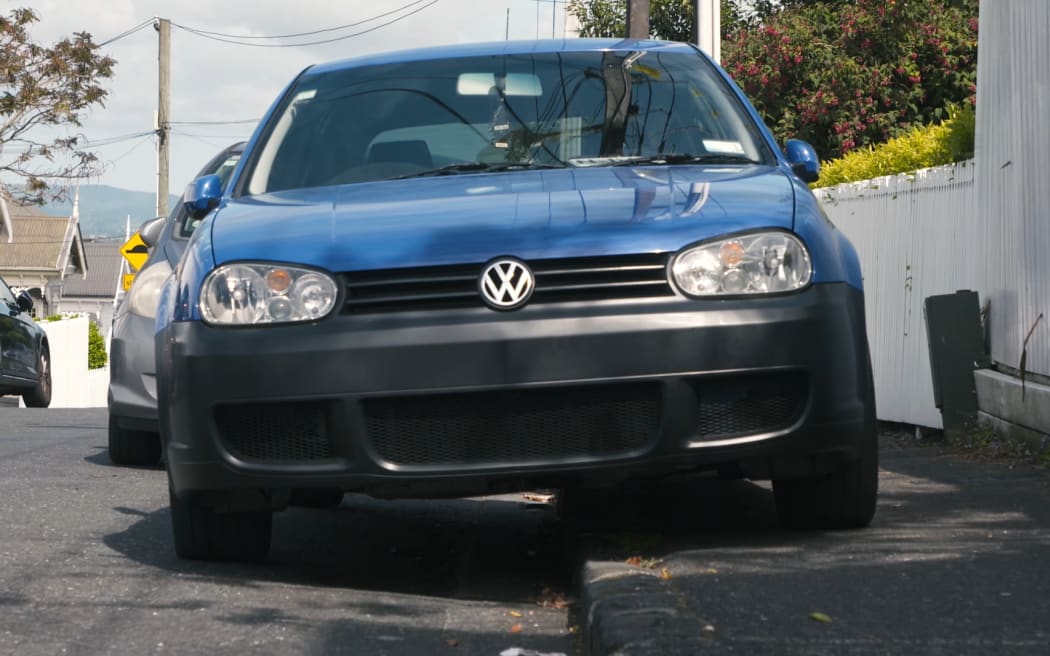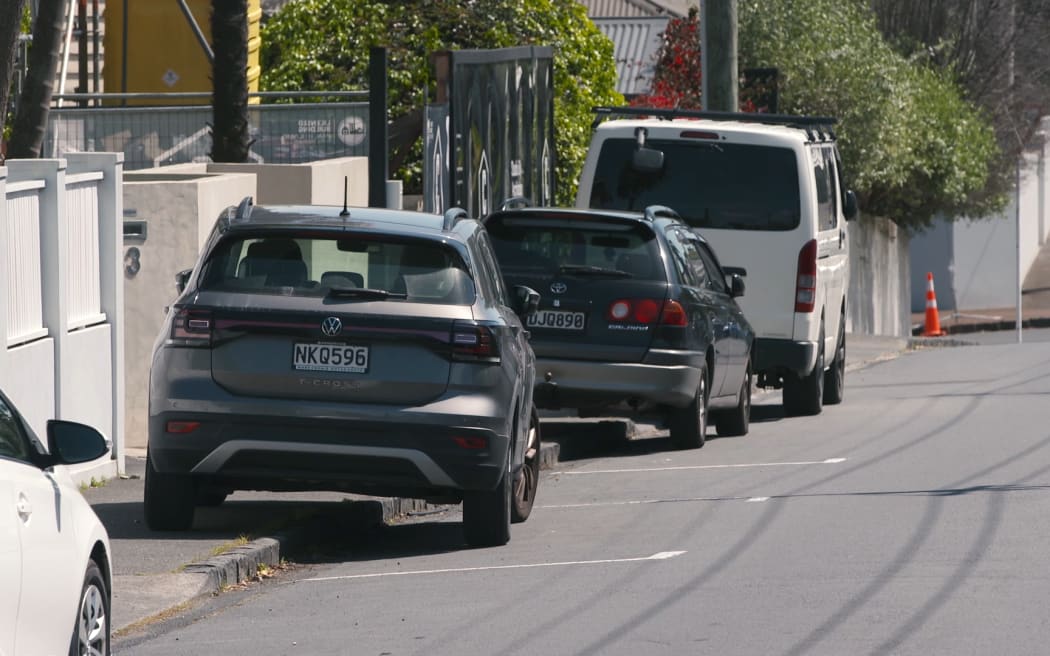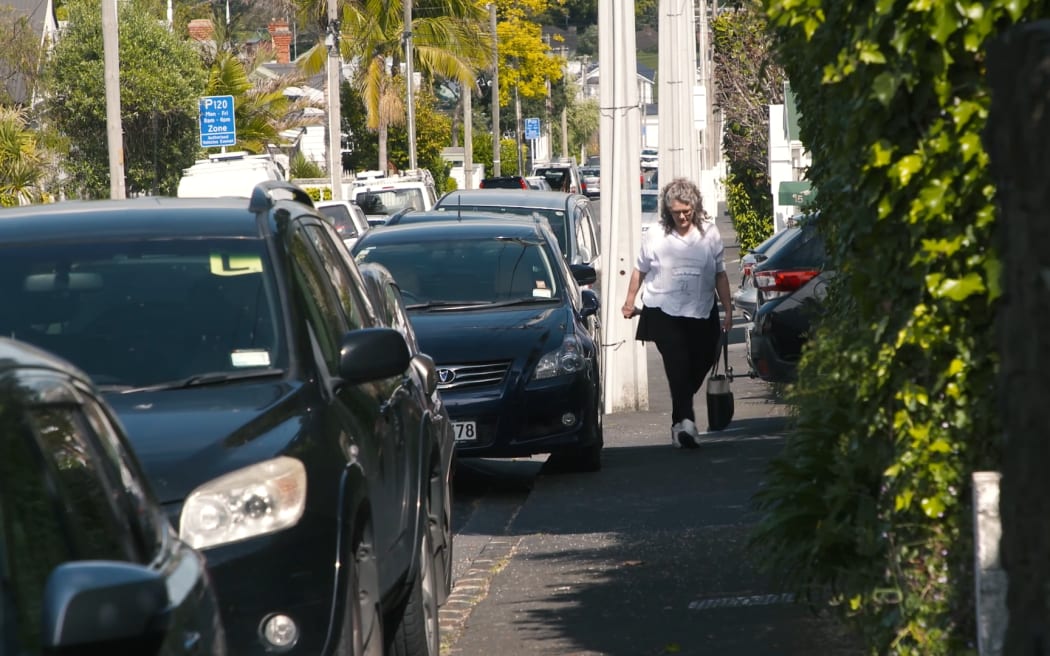Parking on the footpath is illegal anywhere in New Zealand, but councils across the country are taking different approaches to enforcing the rules.
When it comes to Aucklanders' parking habits, there's a tension between what's legal and what's practical.
On some of the city's slimmest streets, drivers are faced with a choice between parking partially on the footpath to allow traffic through, or parking on the road to allow pedestrian access.
But while some residents say it's just part of living in a city, for the disability community, it can pose problems of accessibility.

Pedestrians try to use the footpath in Auckland where cars are parking over the kerb. Photo: RNZ / Nick Monro
When asked how to park considerately on narrow streets, Aucklanders had varying responses.
"As close to the footpath or on the kerb as possible, otherwise you can't get down the street," one resident said.
"They need to be doing a balance between leaving enough room on the footpath for people to get past, and being enough off the road that cars can get past," another said.
"The road is for parking; the footpath is for walking," a third resident said.
According to Auckland Transport, the rules were clear: Footpaths were for pedestrians, and it was a violation to block them.
But some of those who lived on Auckland's narrow streets said the reality of the situation demanded a common-sense approach.
A Ponsonby resident said his parents once complained about a ticket they received for parking on the footpath.
"They said, 'You can't get a truck down here, let alone a fire truck - what happens if someone's house catches fire?'."
The New Zealand Road Code stated that people could not park in the way of other people using the road, including pedestrians.
It clarified that meant no parking on any footpath.
CCS Disability Action educator Vivian Naylor said that was the way it should be.
"Pedestrians have to be the foundation on which everything else is built, and if they're not taken into the equation, then we're never going to get a decent environment for them to operate in safely."
Naylor said people parking on footpaths needed to have more consideration for the disability community.

CCS Disability Action educator Vivian Naylor. Photo: RNZ / Nick Monro
People using wheelchairs often kept to routes with well-designed crossings and kerb ramps which they knew they could safely navigate, she said.
"To suddenly have this barrier in the way of a vehicle inconveniently parked throws you out completely, and you might actually have to reverse your journey and find another route."
For people with vision impairments, the path could be even more challenging to negotiate.
"There's suddenly this obstacle in the way... Are they going to step into the road in order to get out of the way?" Naylor said.
"They have no idea what traffic is coming in their direction and the more electric cars we have, the quieter the traffic is going to be.
"That just adds to the hazard of it all."

Pedestrians try to use the footpath in Auckland where cars are parking over the kerb. Photo: RNZ / Nick Monro
Auckland Transport head of transport and parking compliance Rick Bidgood said the council organisation had considered people with disabilities in its stance on footpath parking.
"It's a community-wide issue and everyone needs to be considerate of all other road users," he said.
"Community spirit is a must when it comes to parking."
Bidgood said when parking was inappropriate for an area, a lot of damage could be done to private vehicles - especially their wing mirrors.
He said that on narrow streets, AT could address parking issues by placing broken yellow lines, either down one side of the street or staggered down both sides.
AT could issue fines of $40 for footpath parking breaches, and in the last seven months issued almost 6000 of these fines - about $240,000 in total.
However, in issuing an infringement AT had to spend more than $30 on average, plus further costs to tow a vehicle, meaning the organisation could actually lose money enforcing the law.
Parking on the footpath was illegal anywhere in New Zealand, but councils across the country could take different approaches in their enforcement of the offence.

Pedestrians try to use the footpath in Auckland where cars are parking over the kerb. Photo: RNZ / Nick Monro
In Christchurch, an attending officer determined whether an offence was committed based on how much obstruction or damage the parked vehicle caused.
"If a vehicle is parked parallel to the kerb with two wheels on the kerb edging rather than the footpath or a grass berm, then an infringement notice would generally not be issued," Christchurch City Council transport operations manager Stephen Wright said.
In Wellington, from 2005 until last year, the council took a hands-off approach for any footpath parking breaches other than in the central city - as long as vehicles left at least a metre of footpath for pedestrians.
The council now enforced the rules everywhere, but prioritised areas that received a lot of complaints or where parked vehicles were causing danger and inconvenience.
A spokesperson said that any vehicles with two wheels on a footpath could attract a ticket if causing a hazard.
Wellington City Council also ticketed vehicles parked on grass verges due to the damage it caused.

